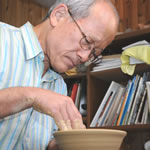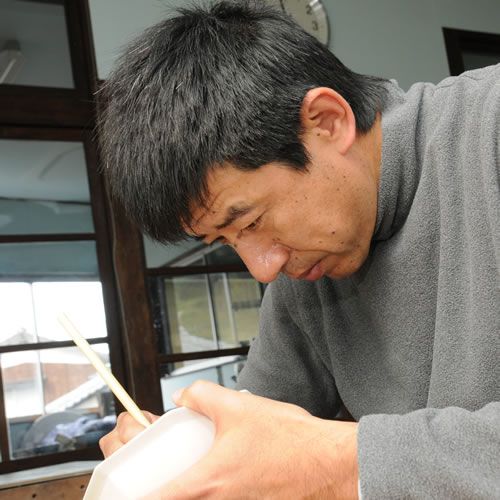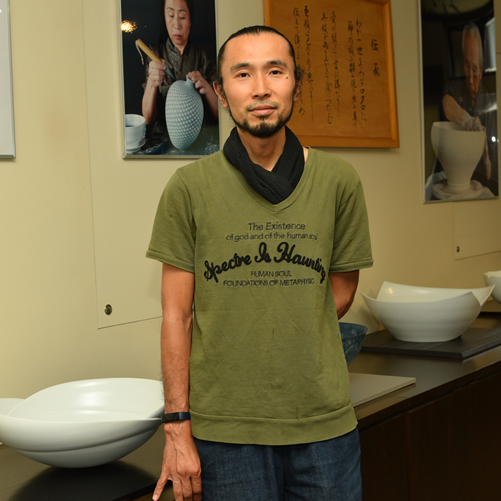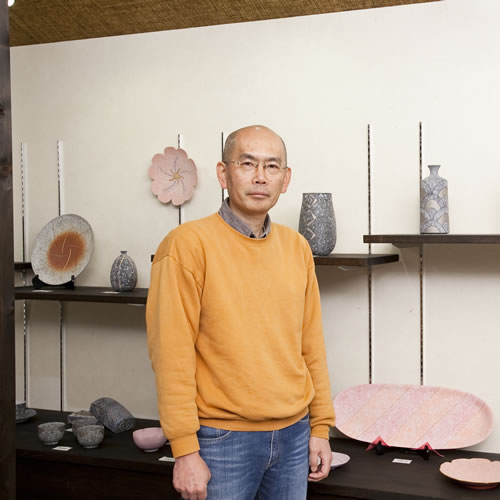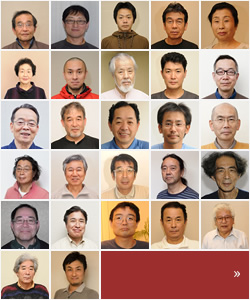Hagi Ware
The ceramic which was loved from ancient times by a master of tea ceremony, and had the property for soil's character (tsuchiaji) and profound beauty
Hagi Ware is the pottery which is fired in Yamaguchi prefecture, with a focus on Hagi-shi. It is called "First Raku Second Hagi and Third Karatsu ", many masters of tea ceremony became familiar with Hagi Ware for a long time. It is the glazed pottery which Korean's technique was transferred with the forming by kicking the potter's wheel and using straw and ash glaze.
It is beginning that after the Bunroku Keicho era, Lord MORI,Terumoto invited the two Korean brothers Li Shao Guang and Li Jin, and let them make the feudal clan kiln under the castle in 1604. Hagi Ware transmitted to the actual, there are a lot of tea utensils, it is widely known as the ware which expresses the beauty of tea ceremony with a a strong air leading to glazed pottery made in Korea like Korai tea bowl.
The feature of Hagi Ware is soft for touch, mouth and changing the colours is mentioned. It is called Hagi no nanabake (the ware changes the tone of color "seven times") describing Hagi tea bowl. After you use tea bowl for a long time, tea stains penetrate into minute cracks on the surface, changing the colors and its elegance will become deep gradually. In addition to arising the flavorful change by repeating the tea ceremony, it seems to be the case to point out the similarity with Korai tea bowl. In the text which tells Hagi Ware as a superior tea utensils, the nuance of Korai tea bowl's lineage was emphasized, and the originality of Hagi Ware may be hidden. Although there is more than figurative similarity in Korai tea bowl, superficial similarity isn't based on essential identity, it will be never supposed to confuse them. The shape of tea bowl is the expression by tea masters itself. You will make out how Hagi Ware pursuits the original shape by focusing on how Hagi Ware adopted the fugative elements which forms the expression shape of Korai tea bowl by coping, or how it was arranged freely.
One of the feature of Hagi Ware is Kodai (foot). Warikodai (sprit foot) of Korai tea bowl is the main, and the variation of the shapes such as Takegushi kodai (bamboo node foot), Kiri kodai (cutting foot), Sakura kodai (foot which modeled on cherry blossoms flower) was added. Both of them has the natural engraving for high and low, thickness, way of cutting and skill for the spatula is esteemed.
The original clay of Hagi Ware is based on Daidotsuchi, Mishimatsuchi, and Mitaketsuchi, and it is mixed with its local clay of each kiln's location along the ceramic. It is fired in the multi-chambered climbing kiln which is built used by the slope with good water supply. The time of firing depends on the number of chambers, and the wood is usually firing for about 15 hours in the kiln. Red pine woods which is torn thick are used as the fuel. After firing, each chamber is closed consecutively, gradual cooling is done from 5 days to 7days, and takes pottery out from the kiln.
In Taisho era (1912-1926), one ceramic artist studied old pottery with loved and pursuited the world of its traditional beauty. Its trend spread into all of Japan, and the 13th potter, MIWA, Kyusetsu encouraged the research in Hagi with ARAKAWA, Toyozo in Mino, KANESHIGE, Toyo in Bizen. Especially, adding the original improvement into Hagi Ware's straw and ash glaze, to announce the white glaze called Kyusetsujiro might be the special achievement which contributed to the progress in Hagi Ware.
Now ceramic artists with full of sensitivity try to produce the expression area by various expression form and their new arts is launched in the world.
Origin and characteristic of Hagi pottery
In the Keicho era, about 400 years ago, Load MORI, Terumoto invited two Korean brothers Li Shao Guang and Li Jin, who settled down in Hagi and introduced the Korean pottery and technique from the Koryo dynasty (Korai in Japanese, 918-1392) this pottery was very appreciated by tea masters for its natural and ordinary beauty. Their ground work later developed into the well-known Hagi yaki, mainly as a tea ceremony ware.
Hagi pottery is a slightly porous stoneware. During use, it absorbs the tea and stains the ware then a fine netting of crackle appears. It is said that the ware changes the tone of color "7 times", highly appreciated by users.
Gonzaemon, the founder of Seiunzan Kiln, was born in Hizen, Saga prefecture. To study pottery, he traveled around Japan. He liked Hagi Ware and the town so much and decided to build his house and the kiln in Maeobata, Eastern suburb of Hagi in 1782. He also studied his pottery to the Lord MORI, Narifusa. He appreciated it so much and prompted him to Samurai rank in 1796 with allowance.
Since the foundation of the first kiln 200 years ago, the Okada family made much effort to carry on the tradition and improve the pottery making to the present time.
Senshu, seventh generation potter of the Okada family, passed away in January 2003.
We use the seal and name of Senshu or Seiunzan on our pottery to honour his name and technique.
The Use of Hagi Ware
Since Hagi Ware easily absorbs the sake, or tea through tiny crackles, the color of Hagi Ware's surface will be changed.
Please pay attention to the following instruction.
Soak the new Hagi ware in water before use.
Wash and dry it well after use.
Since the ware sometimes has a rough foot-ring, be cautious about using it on lacquer ware.
Do not use it in a microwave or ordinary oven.

